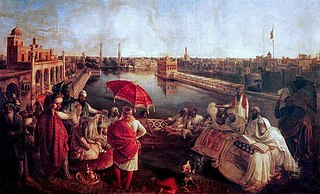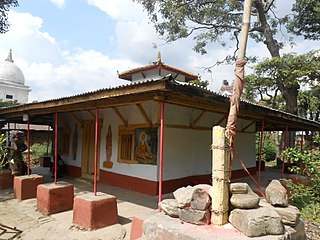Related Research Articles

Sikhism, also known as Sikhi is one of the most recent religious faiths that originated in the Punjab region of the Indian subcontinent, present-day Pakistan, around the end of the 15th century CE. It is the most recently founded major organized faith, and stands at fifth-largest worldwide with about 25–30 million adherents as of the early 21st century.

Sikhs are people who adhere to Sikhism, a monotheistic religion that originated in the late 15th century in the Punjab region of present-day Pakistan, based on the revelation of Guru Nanak. The term Sikh has its origin in the word śiṣya (शिष्य), meaning 'disciple' or 'student'.

Khalsa refers to both a community that considers Sikhism as its faith, as well as a special group of initiated Sikhs. The Khalsa tradition was initiated in 1699 by the Tenth Guru of Sikhism, Guru Gobind Singh. Its formation was a key event in the history of Sikhism. The founding of Khalsa is celebrated by Sikhs during the festival of Vaisakhi.
Adherents of Sikhism follow a number of prohibitions. As with any followers of any faith or group, adherence varies by each individual.
The following outline is provides an overview of Sikhism, or Sikhi.

The Dasam Granth is a collection of various manuscripts in Sikhism containing compositions attributed to Guru Gobind Singh. Guru Gobind Singh ordained the sacred text Guru Granth Sahib as his successor, eternally ending the line of human Gurus. It is the primary holy scripture of the Sikhs and regarded by Sikhs as the living embodiment of Ten Gurus. Bachittar Natak is a part of composition

The Ardās is a set prayer in Sikhism. It is a part of worship service in a Gurdwara, daily rituals such as the opening the Guru Granth Sahib for prakash or closing it for sukhasan in larger Gurdwaras, closing of congregational worship in smaller Gurdwaras, rites-of-passages such as with the naming of child or the cremation of a loved one, daily prayer by devout Sikhs and any significant Sikh ceremonies.
The Damdamī Ṭaksāl is an orthodox Sikh cultural and educational organization, based in India. Its headquarters are located in the town of Mehta Chowk, approximately 40 km north of the city of Amritsar. It has been described as a seminary or “moving university” of the Sikh countryside.

The Nishan Sahib is a Sikh triangular flag made of cotton or silk cloth, with a tassel at its end. The word, Nishan Sahib means exalted ensign, and the flag is hoisted on a tall flagpole, outside most Gurdwaras. The flagpole itself, covered with fabric, ends with a Khanda on top. The emblem on the flag is known as Khanda, which depicts a double-edged sword called a khanda (☬) in the centre, a chakkar which is circular, and flanked by two single-edged swords, or kirpans. Almost all Sikh warriors used to wear it in the eighteenth century, and Nihangs of today still do. The Khanda Sahib is not to be confused with the Nihang's Aad Chand which was the first symbol of the Khalsa. The Khanda was not introduced by Guru Hargobind Sahib Ji but it was a plain yellow banner.

Udasi is a religious sect of ascetic sadhus centred in northern India. Becoming custodians of Sikh shrines in the 18th century, they were notable interpreters and spreaders of the Sikh philosophy during that time. However, their religious practices border on a syncretism of Sikhism and Hinduism, including idolatry, and they did not conform to the Khalsa standards as ordained by Guru Gobind Singh. When the Lahore Singh Sabha reformers, dominated by Tat Khalsa Sikhs, would hold them responsible for indulging in ritual practices antithetical to Sikhism, as well as personal vices and corruption, the Udasi mahants were expelled from the Sikh shrines.

Sikhism has no specific teachings about homosexuality and the Sikh holy scripture, the Guru Granth Sahib, does not explicitly mention heterosexuality, homosexuality or bisexuality.
The Akhand Keertanee Jathaa (AKJ) is a jatha of Sikhism dedicated to the Sikh lifestyle. The Jathaa follows a strict discipline in keeping the Rehat of Guru Gobind Singh Jee. They also enjoy an active style of Keertan recited by Sikhs in a collective manner in front of Sree Guru Granth Sahib Jee. This style of Keertan is relatively simple, and the entire congregation devotionally participates in singing along.

Nitnem is a collection of Sikh hymns (Gurbani) to be read minimally 3 different times of the day. These are mandatory and to be read by every Amritdhari Sikh as expressed in the Sikh Rehat Maryada. Optionally additional prayers may be added to a Sikh's nitnem. There are five hymns (Five Banis) to be done during Amrit Vela, the Rehras Sahib hymn for the evening and Kirtan Sohila for the night. The morning and evening prayers should be followed by an Ardaas.
The Sikh Rehit Maryada is a code of conduct and conventions for Sikhism. The final version of the Rehat Maryada was approved by the Shiromani Gurdwara Parbandhak Committee, Amritsar in 1945. The Rehat Maryada was created to provide guidance to Sikhs on practical and functional aspects of daily life, including the operations of Sikh Gurdwaras, and religious practices to foster cohesion throughout the community.

Jhatka, or Jhataka or chatka, is the meat from an animal killed instantaneously, such as by a single strike of a sword or axe to sever the head within the Sikh religion. This type of slaughter is preferred by most Sikhs as well as meat-consuming Buddhists and some khatiks of the Punjab region and North India, also within this method of butchering the animal must not be scared or shaken before the slaughter.
Nirankari is a sect of Sikhism. It was a reform movement founded by Baba Dyal Das in northwest Punjab in 1851. He sought to restore the practices and beliefs of Sikhs back to what he believed were prevalent when Guru Nanak was alive. This movement emerged in the aftermath of the end of Sikh Empire and the Sikh history after Ranjit Singh's death.
Followers of Sikhism do not have a preference for meat or vegetarian consumption. There are two views on initiated or "Amritdhari Sikhs" and meat consumption. "Amritdhari" Sikhs can eat meat ."Amritdharis" that belong to some Sikh sects are vehemently against the consumption of meat and eggs.
Sikhism has often been criticised by non-Sikhs regarding its texts, practices, and societal norms, but Sikhs and other scholars argue that these criticisms are flawed and are based on a biased and poor understanding of the texts, especially of the multiple languages used in the Sikh scriptures. They also argue that most western scholars who attempted to interpret eastern religious texts, were missionaries and could not overcome the bias they carried with them, irrespective of whether they were translating the Quran, Vedas, Puranas of the Guru Granth Sahib. Guru Nanak rejected ritualistic worship and encouraged belief in one true God, Waheguru. The veneration and bowing to the Guru Granth Sahib, has often been interpreted by western scholars as akin to idolatry, as observed by the Hindu faith, which defeats the ideology of Guru Nanak. Other scholars dismiss Sikhism as, either consciously or spontaneously, a syncretism of the Hindu Bhakti and Muslim Sufi movements.

Amrit Velā refers to integral religious time used for daily meditation and recitation of Gurbani hymns, during last part of the night before the dawning of the early morning sun. This is according to the Pahar system of time most Sikhs typically translate this time to start 3:00am. Guru Nanak in the Japji Sahib says, "In amrit velā meditate on the grandeur of the one true Name." The importance of Amrit Vela is found throughout the Guru Granth Sahib. The Guru Granth Sahib states that "those who consider themselves a Sikh must wake up daily at Amrit vela and be in tune with the Naam "

Sub-traditions, also known as Samparda in Punjabi language are sub-traditions within Sikhism that believe in different approaches to practicing the religion. While all sampradas believe in Waheguru and one creator, do not believe in idol worship or caste system, different interpretation have emerged over time, some of which practise having a living teacher as the leader orthodox. The major historic traditions in Sikhism, states Harjot Oberoi, have included Udasi, Nirmala, Nanakpanthi, Khalsa, Sahajdhari, Namdhari Kuka, Nirankari and Sarvaria. During the persecution of Sikhs by Mughals, several splinter groups emerged such as the Udasis, Minas, and Ramraiyas during the early Guru period during the period between the death of Guru Har Krishan and the establishment of Guru Tegh Bahadur as the 9th Sikh Guru. These sects have had considerable differences. Some of these sects were financially and administratively supported by the Mughal Empire in the hopes of gaining a more favorable and compliant citizenry.
References
- 1 2 Horace Hayman Wilson; Reinhold Rost (1862). Essays and Lectures Chiefly on the Religion of the Hindus by the Late H. H. Wilson: Miscellanuous essays and lectures. 2. Trubner. pp. 148–149. Retrieved 14 November 2015.
- 1 2 Tulsi Patel (2007). Sex-Selective Abortion in India: Gender, Society and New Reproductive Technologies. SAGE Publications. pp. 242, 419. ISBN 978-0-7619-3539-1 . Retrieved 14 November 2015.
- 1 2 Veena Talwar Oldenburg; Veena Talwar (2010). Dowry Murder: Reinvestigating A Cultural. Penguin Books India. p. 23. ISBN 978-0-14-306399-5 . Retrieved 14 November 2015.
- 1 2 W. H. McLeod (24 July 2009). The A to Z of Sikhism. Scarecrow Press. pp. 65–66, 119. ISBN 978-0-8108-6344-6 . Retrieved 14 November 2015.
- 1 2 Quintin Craufurd (1817). Researches Concerning the Laws, Theology, Learning, Commerce Etc. of Ancient and Modern India. - London, T. Cadell & W. Davies 1817. T. Cadell & W. Davies. pp. 344–345. Retrieved 14 November 2015.
- 1 2 Amardeep S. Dahiya (1 December 2013). Founder of the Khalsa: The Life and Times of Guru Gobind Singh. Hay House, Inc. p. 146. ISBN 978-93-81398-61-6 . Retrieved 14 November 2015.
- ↑ Kamlesh Mohan (2006). Towards Gender History: Images, Identities, and Roles of North Indian Women with Special Reference to Panjab. Aakar. pp. 37, 52. ISBN 978-81-87879-65-7 . Retrieved 14 November 2015.
- ↑ Later Mughal. Atlantic Publishers & Distri. 1971. p. 81. GGKEY:127HGC10PTU. Retrieved 14 November 2015.
- ↑ Pashaura Singh; Louis E. Fenech (27 March 2014). The Oxford Handbook of Sikh Studies. OUP Oxford. p. 620. ISBN 978-0-19-100411-7 . Retrieved 14 November 2015.